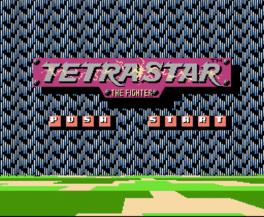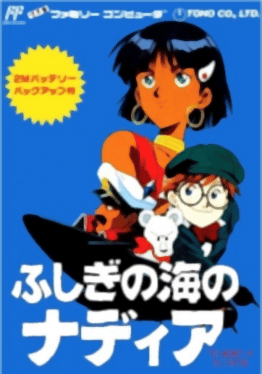New Famicom Games - Page 22
-
Nantettatte!! Baseball '91 Kaimaku-hen
1991
Nantettatte!! Baseball '91 Kaimaku Hen is a Sports game, developed and published by SunSoft, which was released in Japan in 1991. -
Shin 4-nin Uchi Mahjong: Yakuman Tengoku
1991
The sole installment of the Yakuman series on the Famicom. Shin 4-nin Uchi Mahjong: Yakuman Tengoku is a Miscellaneous game, published by Nintendo, which was released in Japan in 1991. -
Tetrastar: The Fighter
1991
Tetrastar The Fighter is a 3D shooter by Home Data and published by Taito. In the year 2089, humanity forms an alliance with the intergalactic Baal empire but soon Earth finds out about the alien's true intentions. A group of resistance assembles the project Tetrastar to prepare for the potential upcoming threat. But the project lead by the general Nelson is soon put on hold and a short lived peace settles in. But the whole thing was nothing more than a hostile invasion and the Baal empire finally breaks the alliance and attacks Earth. The player's first mission is to prevent New York to be destroyed and then to retrieve Omega, the faithful robot navigator, to warp to the alien's mother world. The Tetrastar super fighter can move around the screen and fire a standard Vulcan gun. Special weapons become available later in the game from Bombs (WID), Homing Missiles (AAM), Napalm Bombs (NAP) and the powerful Bio Cannon (BIO) - they are accessible via the Select button and triggered by pressing A. They all come in limit -
Ninja Ryuukenden III: Yomi no Hakobune
1991
The original Japanese version of Ninja Gaiden III. When the game was ported to North America, the game was made harder on purpose with the removal of the password feature and with a boost of damage inflicted by the enemies. -
Hiryuu no Ken Special: Fighting Wars
1991
MMA-styled fighting game where each character represents a fighting style, and each style is represented by two characters. -
Fuzzical Fighter
1991
Fuzzical Fighter
1991
The Dimensional Stone, which is required to maintain balance in the world of starship pilot Mark was stolen. The king finds a hero to retrieve the stone; using the "Fuzzical Fighter" to transport the player's character into enemy territory. Towns are visited in-between stages to provide the player with weapons and artificats that are bought with the in-game gold currency. Players can choose to backtrack to either to previous stage while staying at the inn or to a stage that he has not yet explored. They also have access to three different kinds of healing spells: Riken (minor healing), Rikento (normal healing) and Rikentaru (major healing). Despite being a mechanical object and not a creature, the Fuzzical Fighter has magic points that can be replenished while in the towns. The Fuzzy Fighter itself resembles a spaceship with a mechanical tail at the end. -
Palamedes II: Star Twinkles
1991
Palamedes II is a puzzle game and, as it sounds, the sequel to an obscure NES puzzler. The object is to throw one of the player’s dice at a die with the same number or one away. When you clear a die, it is added to the player’s poker-like “hand” and the bottom of the screen. When you’ve got a winning hand, you can use it clear multiple lines at once. The game has two modes: Mode 1 is a survival mode and Mode 2 is a screen-clear mode. -
Mah-Jong Club Nagata-cho: Sousaisen
1991
Mah-Jong Club Nagata-cho: Sousaisen is a Miscellaneous game, published by Hect, which was released in Japan in 1991. -
Cocoron
1991
Cocoron
1991
Tapir, an enigmatic blue wizard in spotted pajamas from the Dream World, sends the player on a quest to rescue princess Rua. But things quickly become more complicated and the player soon has to rescue other characters along the way, such as Santa Claus, the king of Trump castle and the blue fairy Cocoron. Tapir can manipulate people's dreams and this ability gives Cocoron an unique twist - the player can assemble his own character by combining one of the eight available heads to one of the eight available bodies (which both include several designs to choose from, resulting in literally hundreds of combinations! ). More than a mere physical appearance, each part also defines the character's attributes, such as his health, speed, how high he can jump and so forth. -
Kero Kero Keroppi no Daibouken
1991
Kero Kero Keroppi no Daibouken is based on the popular Sanrio character Keroppi. Released on the Nintendo Family Computer console in Japan in 1991. Big Adventure is a children's puzzle game where Keroppi must rescue his girlfriend Keroleen who is locked up in a castle. To do so, he must solve the action based puzzles in seven differently themed worlds with four different types of stages (the surface of the maze, flying a plane, a Reversi-like level, and through a field of lava). All the items in the game are pre-determined; there is a need to memorize the pattern for each playthrough so that a player may advance through the levels more quickly once they have achieved a degree of expertise in the game. -
Shikinjou
1991
Shikinjou
1991
Shikinjou, or Shikinjoh, is a puzzle game inspired by Mahjong Solitaire and Sokoban. Like most Mahjong Solitaire variants, it takes its name from a region in China: in this case, the former Imperial Palace of China, also known as The Forbidden City. The goal of the game is to get the protagonist, who is a jiang shi by default, to the exit. To do this they must push mahjong tiles out of the way. Most mahjong tiles will disappear once they touch one or more of the same type, and these tiles will also vanish along with it. Some, like the dragon or wind tiles, are barricades that will transform any tile that comes into contact into another barricade. The player can also switch graphical modes, which changes all the tiles, the protagonist, and even the background and UI. These graphical modes include alternative themes like space, medieval knights, and Japanese ninja (with shogi tiles replacing the mahjong tiles). -
Oeka Kids: Anpanman no Hiragana Daisuki
1991
An educational game to teach children Hiragana. Oeka Kids: Anpanman no Hiragana Daisuki is a Miscellaneous game, developed by TOSE and published by Bandai, which was released in Japan in 1991. -
Lagrange Point
1991
Lagrange Point
1991
In the 22nd century, mankind has begun to emigrate into outer space. Constructed at a lagrange point were three huge space colonies: the Isis Cluster (two artificial biospheres, named Land-1 and Land-2, and a satellite). In the year Isis 0024 (55 years after the cluster was constructed), however, a biohazard outbreak occurred on Land-2. All attempts at contact were met with nothing but static. Now a research team led by pilot Jin approaches Land-1 -
Itadaki Street: Watashi no Oten ni Yottette
1991
Itadaki Street: Watashi no Oten ni Yottette is a Miscellaneous game, developed by Game Studio and published by ASCII Entertainment, which was released in Japan in 1991. A board game, similar to monopoly, with a large cast of characters released for the Famicom on March 21, 1991 in Japan. -
Ninja JaJaMaru: Ginga Daisakusen
1991
Ninja JaJaMaru: Ginga Daisakusen is an Action game, developed and published by Jaleco, which was released in Japan in 1991. -
Shadow Brain
1991
Shadow Brain
1991
Shadow Brain is a Role-Playing game, developed by Scitron & Art and published by Pony Canyon, which was released in Japan in 1991. -
Fushigi no Umi no Nadia
1991
Fushigi no Umi no Nadia is a Strategy game, developed by Advance Communication Company and published by Toho, which was released in Japan in 1991. -
Namcot Mahjong III: Mahjong Tengoku
1991
Namcot Mahjong III: Mahjong Tengoku is a Miscellaneous game, developed and published by Namco, which was released in Japan in 1991. -
Tenchi wo Kurau II: Shokatsu Koumei-den
1991
A Japanese roleplaying game published for the NES in 1991. Based on the manga Tenchi wo Kurau. Tenchi o Kurau II: Shokatsu Koumei-den ("The Devouring of Heaven and Earth II: The Story of King Ming") is a turn based roleplaying and strategy game developed and published for the Nintendo Entertainment System by Capcom on April 5th, 1991 in Japan. It is the second NES RPG produced by Capcom based upon the Tenchi wo Kurau manga series, the first being Destiny of an Emperor released in 1989. Gameplay: A traditional Japanese roleplaying game at its core, Tenchi o Kurai II puts the player in control of a party of warriors and mages as they try to take down a great foe that threatens the peace of their land. Throughout there are random encounters, boss battles, an experience system and valuable and/or useful loot. The player's party can hold up to seven members at a time, with one members acting as a "tactician". The tactician determines the list of tactics available for use by the player during battle. -
Obocchamakun
1991
Obocchamakun
1991
Obocchamakun is a Miscellaneous game, published by Tecmo, which was released in Japan in 1991. This board game is played by up to four players, and the victory condition is to receive a kiss from the heroine. The map, which resembles a world map, is divided into Europe, Asia, the Soviet Union, Africa, North America, South America, the North Pole, the South Pole, and Tamba World (the underworld), and players must find the treasure demanded by the heroine among them. Treasures obtained by other players can be taken away by physical assault or by using items. Players can earn the necessary liking points to receive a kiss when they deliver the treasure they have found to a randomly selected city where the heroine is staying. When the player reaches the number of points set before the game begins, the player wins a kiss from the heroine.



















